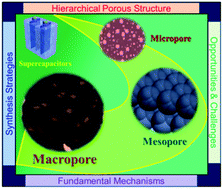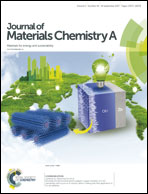Revitalizing carbon supercapacitor electrodes with hierarchical porous structures
Abstract
Carbon materials, owing to their excellent electrical conductivity, tailorability, inexpensiveness and versatility, have been extensively studied as electrode materials for supercapacitors. The capacitance of carbon-based supercapacitor electrodes has remained at a mediocre level between 100 and 200 F g−1 for decades. Until recently, a new family of carbon materials termed hierarchical porous carbons has pushed the capacitance to new benchmark values beyond 300 F g−1, and has revitalized the exploration of carbon materials for supercapacitors. Hierarchical porous carbons contain different scales of pores (from micropores to macropores) inter-connected together and assembled in hierarchical patterns. Experimental studies coupled with theoretical investigations have elucidated that the presence of micropores is responsible for offering a large surface area to enhance charge storage capability, whilst mesopores, macropores and the hierarchical structure improve electrolyte infiltration and facilitate ion diffusion. This review will start by introducing different pore types and the definition of hierarchical porous structures, followed by discussion and exemplification of major synthesis strategies. In addition, recent molecular-level understanding of the relationship between pore size, functionalities inside pores, pore spatial distribution and capacitive performance is presented. Finally, challenges and future opportunities associated with hierarchical porous carbons for supercapacitors are discussed.

- This article is part of the themed collection: Recent Review Articles


 Please wait while we load your content...
Please wait while we load your content...